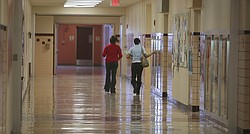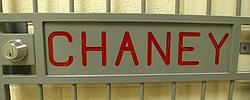A day at Chaney
Chaney

For the past few months, there have been reports of fighting and other problems at Chaney High School on the city’s West Side. The Vindicator spent a day last week at the school to see what happens inside the building during a regular school day, which consists of eight class periods. The schedule:
7:30 a.m. Doors open with breakfast provided in the school cafeteria. Students arrive by school or Western Reserve Transit Authority buses or by their own transportation.
8 a.m. The bell rings for the day’s first class.
10:50 a.m. to 1:05 p.m., three 45-minute lunch periods.
3 p.m. Dismissal. Students leave the school and board buses or drive home.
Story by DENISE DICK | Photos by ROBERT K. YOSAY & RAMI DAUD
news@vindy.com
YOUNGSTOWN
For all the stories of students behaving badly at Chaney High School, the scene on a day last week was of relative calm.
Principal Erik Thorson and deans Edna Douglas and James Vivo spent the morning ushering straggling students to their respective classrooms before the bell.
All three officials carried a radio, allowing them to communicate throughout the school.
Doors open at 7:30 a.m. as students eat a school-provided breakfast. The first class begins at 8.
“People forget: This isn’t a neighborhood school anymore,” Thorson said. “We have kids that are bused here from 7 miles away.”
Other kids take Western Reserve Transit Authority buses to school. Many older ones drive.
Thorson visits different classrooms, urging students in a study hall to use the time to prepare for the Ohio Graduation Test.
“I’m encouraging the teachers to have an OGT question of the day,” he said.
In Christopher Patrone’s U.S. History class, the question dealt with the New Deal.
A three-inch-thick binder that reads “Chaney Databook” rests on Thorson’s desk. Inside lists the school’s state report card information for the last few years as well as goals for improvement.
“It’s my bible,” Thorson said. “I don’t go anywhere without it. Look at all the notes — I take it everywhere with me.”
About 820 are enrolled at the West Side high school although some juniors and seniors attend Choffin Career and Technical Center part of the day.
Attendance averages about 89 percent with the state setting the benchmark at 93 percent.
Thorson is new to the district, coming from Cleveland schools. He started in late September, nearly a month after the beginning of the school year.
Students moved between classes without confrontation. Some approached Thorson with problems: they need to recover credits in order to graduate, a teacher isn’t enforcing the dress code consistently, they need a pass to class.
The only time of chaos was during a morning language-arts test for ninth graders that’s required by the state. It took about 15 minutes for students to get seated, settle down and listen before Thorson and ninth-grade teachers could distribute pencils, test books and test sheets.
More confusion ensued when about 30 students didn’t have test sheets with their names printed on them. Because the students’ names are required for the data to be input, those students have to take the test another day.
While most of the day progressed smoothly, a city police report shows that a fight broke out after school hours during basketball practice. One boy went to the emergency room with a broken jaw.
Thorson acknowledged that the previous day saw a couple fights in the cafeteria. When there are fights, girls are usually the ones fighting and it’s usually about something that started outside of school on a social network such as Facebook.
The school has three Youngstown police officers contracted by the district, assigned to Chaney through the day — two inside and one outside.
One of those officers said he sees problems with students using profanity and being disrespectful and sometimes threatening school personnel and the officers.
Another officer, though, says a day when a fight breaks out is the exception, not the rule. A day without incident is the norm.
Students agreed.
There are some problems, said senior Adam Nieves, 18, but most students are there to get an education.
“I came back for a fifth year after dropping out for a year and a half and working at a dead-end job,” Nieves said.
He now understands that a high school diploma is crucial to secure a job.
But too often, students who are disruptive interrupt learning for the whole class, he said. Teaching stops while the teacher deals with that student.
“They put rules before education,” said senior Albert Jones, 18. “They should put education first.”
Senior Christina Thacker, 18, gets frustrated with the perception that there’s nothing good happening at the school.
“Because something comes from Chaney doesn’t mean that it’s bad, doesn’t mean that it’s sloppy,” she said. “Most of us are here to get an education.”
Tashyra Clark, also 18 and a senior, said academics suffers because some classes lack sufficient textbooks. She listed science, English and business classes as examples.
In some of those classes there’s not enough books for students to take them home. In others, books are so scarce that students have to share them.
Another problem, the students said, is enforcement of the dress code.
At the beginning of the school year, polo shirts with insignia were permitted as long as the insignia was no larger than a quarter, Tashyra said.
Now, students can’t wear any insignia, she said.
“After I spent $100 on school clothes, I had to go buy new shirts,” Tashyra said.
Lunch consists of three 45-minute periods with a dean assigned to each session.
Thorson and Evelyn Beal, a teacher on special assignment who works with special education, sit at the front of the cafeteria, checking off student names as they enter. It’s to ensure students at lunch are supposed to be there.
Boys sit on one side of the cafeteria with girls on the other. Thorson instituted that change after seeing too much hugging, too many students sitting on each other’s laps and other behavior he deemed inappropriate for school.
For the day’s third lunch period, Thorson takes boys who are done eating into the gym to play basketball. He keeps score.
“They need an outlet,” he said.
The boys play hard, sweat dripping down their temples as they return to class.
Kevin Douglas, the school’s linkage coordinator, works in a program called Closing the Achievement Gap, providing ninth-graders with support so they move up to 10th grade.
“If they fail ninth grade, there’s a 60 percent chance of them not graduating,” Douglas said.
He’s working with about 60 freshmen so far this year, sometimes visiting their homes, setting them up with tutors or pointing them to available services.
Students are referred to him if they’re over-age for the grade, have two F’s in core subjects, have been suspended for more than 10 days or if their attendance is below average. Girls may also be referred to Douglas if they’re at risk of pregnancy or violence.
Tina Smith has been with the district for 22 years and teaches ninth grade.
The biggest challenge she sees is reaching students, “explaining to the kids the value of education and how important it is.”
Kids are more apt to quit today than when she started teaching.
“They don’t see the value of education as far as it being the ticket to a better life,” Smith said.
How does she combat that?
“I never let up,” Smith said. “I don’t give up, and I’m a pain. As I am in September, I am in June.”
She hopes things will improve. Connie Hathorn, who became superintendent this month, has been listening to teachers, she said.
She also agrees with Thorson’s decision to name 35-year teacher Ron Burdis to work on special assignment as a discipline and attendance officer.
That started two weeks ago.
“I can’t think of anyone who would be better,” Smith said. “He’s a disciplinarian, he’s a humanitarian, and he’s an advocate for Chaney High School.”
At the beginning of the day, Burdis sweeps the halls, looking for anyone who’s not in class. Those he finds are sent to in-school suspension.
In-school suspension is new to the school, too.
A student in ISS must spend that class period completing a punitive writing assignment.
For one who’s tardy for the first time, for example, the assignment would be about being accountable for your actions.
“There’s no talking, no interaction,” Burdis said. “It sends a pretty good message.”
The second time, ISS lasts for two periods with three periods for a third time.
The fourth time results in an out-of-school suspension and a call to the parent. The student can’t return to school unless accompanied by a parent.
Students can be sent to ISS for other reasons, and more severe offenses can net a child a place in the room the entire school day.
Richard Scarsella, an intervention specialist, said the discipline problems at Chaney are typical of any high school.
“You can see the hallways are quiet,” he said. “This is a normal day.”
 43
43

